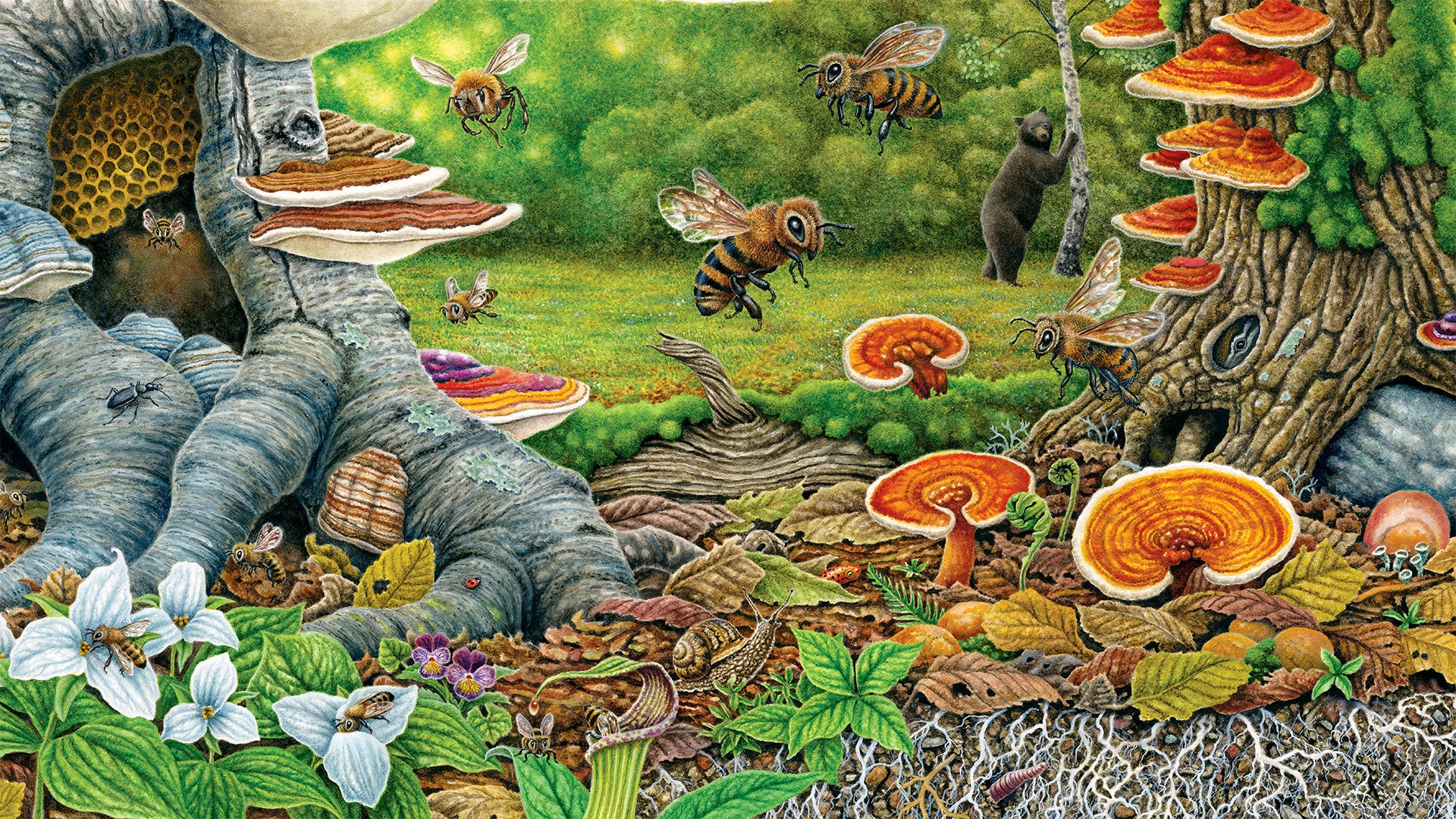
Bee Friendly Research Update 1
Have you heard the buzz? If you saw Paul Stamets’ talk at Bioneers, or have been looking at Host Defense® Breathe dietary supplements lately, you may have seen and wondered about the Bee Friendly™ icon on our products.
Bee Friendly is our initiative to help reverse the devastating declines in the global bee population that are critically threatening the world’s food security.
In California alone, pollination of the almond crop requires 1.4 million honey bee (Apis mellifera) colonies each year, or roughly 60% of managed colonies in the U.S.[i] Since the initial detection of Colony Collapse Disorder in 2006, winter hive losses have averaged 30% annually. Although Colony Collapse Disorder is characterized as an enigmatic situation without a clear cause, it is increasingly understood as the synergism of multiple drivers of collapse.
Unquestionably, the gravest threat to managed beekeeping with temperate honey bee subspecies is the parasitic mite Varroa destructor. Without treatment, this mite typically kills honey bee colonies within two years[ii] and can transmit lethal viruses among honey bee colonies.[iii] Sadly, the most common treatments for Varroa infestation are beekeeper applied pesticides. These, like many other agricultural pesticides, are modestly toxic to bees under healthy hive conditions but can become more dangerous as bee colonies become stressed by mites, diseases, and trans-continental shipping for pollination services.
As a result, many bee colonies managed according to the status quo become immunologically stressed by the synergistic interactions of Varroa mites, the pesticides applied to treat them, and the viruses that the mites may transmit. Eventually, the foraging and reproductive strength of the colony is lost and the colony is propelled toward collapse.
Our Bee Friendly approach to bee colony health stems from the philosophy that synergistic problems require outside-the-box thinking to discover synergistic solutions. A 2014 study surveyed the correlations between 99 distinct pesticides and incidences of hive mortality and disease. The outstanding result was that fungicides were more detrimental to the health of bee colonies than any other class of pesticide surveyed.[iv] While somewhat counter-intuitive that fungicides would be more detrimental to bees than insecticides, the essential roles of fungi in bee hives have been well documented.[v] Indeed, “bee bread”—a fungal fermentation of pollen manufactured in the hive—is an important source of nutrition for the colony, and exposure to fungicides directly reduces the diversity of beneficial fungi in this critical bee food.[vi]
The largely overlooked ecological interactions of bees with beneficial fungi suggest several mycological interventions that we are exploring in our Bee Friendly campaign:
Immune Support: Researching the role that extracts of the mycelium of mushrooms can have in strengthening the immune systems of bees and reducing their viral burden.
Controlling Bee Parasites: Developing ways to use the common bio-control fungus Metarhizium anisopliae to control the parasitic mite Varroa destructor. Significantly, this fungus is safe for bees, birds and humans[vii] and appears to be highly active against Varroa mites.
Detoxification Support: The bee genome has relatively few detoxification genes compared to solitary insects such as flies and mosquitoes. We are planning research to determine if select fungi can produce myconutrients to modulate and up-regulate detoxification pathways in bees.
We are actively working with leading entomologists to develop ecologically rational and environmentally sustainable strategies to improve bee health and offset the use of toxic pesticides in beekeeping. We call this campaign “Bee Friendly.”
It is our hope that, though our ongoing research and partnerships, we can help to slow or even reverse the damage caused by Colony Collapse Disorder. The Bee Friendly logo is one indication of our commitment to supporting critical research in this area, and healthy and sustainable environmental practices in general.
With gratitude for your support,
All of us at Fungi Perfecti® &
Host Defense® Mushrooms
i Colony Collapse Disorder Progress Report. USDA ARS. 2012. http://www.ars.usda.gov/News/docs.htm?docid=15572
ii De Jong D. 1997. Mites: varroa and other parasites of brood, 3rd ed. In: Morse RM, Flottum PK, editors. Honey bee pests, predators, and diseases. Medina: Root. pp. 281–327.
iii Martin SJ, et al. 2012. Global Honey Bee Viral Landscape Altered by a Parasitic Mite. Science. 336, 1304.
iv Simon-Delso, N., Martin, G.S., Bruneau, E., Minsart, L.-A., Mouret, C., Hautier, L. 2014. honey bee Colony Disorder in Crop Areas: The Role of Pesticides and Viruses. PLoS ONE 9(7): e103073. doi:10.1371/journal.pone.0103073
v Gilliam, M. 1997. Identification and roles of non-pathogenic microflora associated with honey bees. FEMS Microbiology Letters, 155: 1-10.
vi Yoder, J.A., Jajack, A.J., Rosselot, A.E., Smith, T.J. 2013. Fungicide Contamination Reduces Beneficial Fungi in Bee Bread Based on an Area-Wide Field Study in Honey Bee, Apis mellifera, Colonies. Journal of Toxicology and Environmental Health. 76:587-600.
vii U.S. EPA, Final Rule. Federal Register Vol. 76, Num. 88 (May 6, 2011)
